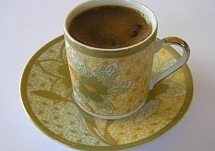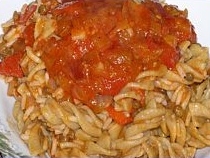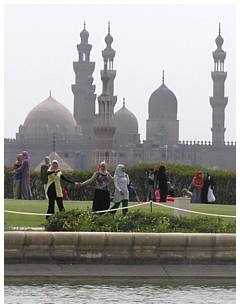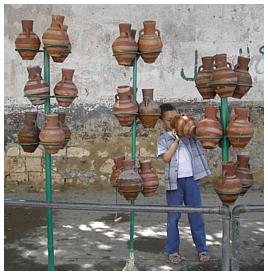|
  Coffee
and tea play a big role in Egyptian life. Tea can be normal tea, mint tea
or karkade, hibiscus tea, cold or warm. With regards to coffee, the choice
is either "Nescafe" or
kahwa, which is called Arabic coffee or Turkish
coffee, for me the choice is easy, as I don't think Nescafe even deserves
the name coffee. Kahwa
is "brewed" by softly
boiling in a very small
special metal pan with a long handle. sometimes with cardamom. It is
served in tiny cups, with part of the coffee itself still on the bottom.
It is invariably served with a large glass of water and always very sweet.
If you order "mazbut" which should mean "little", the most optimistic
thing you can say about it is that the sugar content is "normal". But the
taste is great and it certainly helps you to wake up and put your mind in
order in the morning. Coffee
and tea play a big role in Egyptian life. Tea can be normal tea, mint tea
or karkade, hibiscus tea, cold or warm. With regards to coffee, the choice
is either "Nescafe" or
kahwa, which is called Arabic coffee or Turkish
coffee, for me the choice is easy, as I don't think Nescafe even deserves
the name coffee. Kahwa
is "brewed" by softly
boiling in a very small
special metal pan with a long handle. sometimes with cardamom. It is
served in tiny cups, with part of the coffee itself still on the bottom.
It is invariably served with a large glass of water and always very sweet.
If you order "mazbut" which should mean "little", the most optimistic
thing you can say about it is that the sugar content is "normal". But the
taste is great and it certainly helps you to wake up and put your mind in
order in the morning.
Another food item, which you find everywhere, is
koshary. It is sold on many street corners and costs next to nothing.
It is full of carbohydrates and the combination of pasta, rice and lentils
did not sound particularly attractive to me. Still, after I tried, it
really tasted good. And I can imagine why people eat it, because it keeps
your stomach filled for a very long time. Bread is often part of the meal,
especially
pita bread,
but the most famous bread is shamsi (sun bread), a bread, which is only
available in Upper Egypt (Egypt roughly to the south of
Cairo) and which
rises in the sun on the hot desert sand. For breakfast, the Egyptians like
bean soup or beans, with egg or as filling of a
pita bread. Another loved dish is stuffed
pigeon (hamam mahshi), and you will see many odd shaped houses throughout the country,
which appear to be dovecotes, which house the pigeons before they get
stuffed. |
|
The grey building to the right
above houses chickens, There are many of them in rural areas, and when I
saw the first, I thought it might be a school. But unless the chickens are
extremely intelligent, there will be no teaching taking place there. There
are only chickens, sitting side by side and producing their eggs.
Graveyards are a special sight,
they are almost cities in themselves and the graves may look like
beautiful houses. Every dead body usually gets a room, underneath which he
or she will find rest, and families may plan the whole operation way
ahead. You can often see graveyards if you are looking at the desert while
driving on the highway but then, that road has probably been built a long
time after the first dead body was buried in that graveyard. Sometimes, people live in them, after their wife or
husband died. Even whole families may live there, if they are very poor,
at least it will give them a roof above their heads. But imagine having to
live in a grave already whilst you are not even dead yet. |
|
On the 25th of April, Sinai Day is celebrated. The
Egyptians celebrate their victory in 1972 on the Israelis, at which
occasion they obtained the Sinai peninsula, the biggest beach area in the
world. Each year, Coptic Easter is celebrated by the Copts. About 15% of
the Egyptian population consists of Copts, and they claim to be the
descendants of the Pharaohs. They have to fast 55 days before Easter,
meaning that they are not allowed to eat certain things like meat, fish
and eggs. Of the Copts I have met, there was not even one who performed
the whole 55 days of fast. Some did a week, some did one day, and some
felt that God would not love them less for not having fasted at all.
Nonetheless, the Coptic Easter Sunday starts for many at 12.01 midnight
with an enormous buffet, full of beautiful dishes, almost all of them
meat.
  You
can find public places to drink in the city which have the usual form of a
metal tap, but often, Egyptians are very creative in offering their water
to trespassers. Especially in the neighborhood of
souks, you will find stands
with numerous earthenware jugs of water, which keep the water fresh for
all to drink from. And in the hot season, this may be very welcome, as it
is almost impossible to carry around enough water all day, especially if
you have to do shopping as well. You
can find public places to drink in the city which have the usual form of a
metal tap, but often, Egyptians are very creative in offering their water
to trespassers. Especially in the neighborhood of
souks, you will find stands
with numerous earthenware jugs of water, which keep the water fresh for
all to drink from. And in the hot season, this may be very welcome, as it
is almost impossible to carry around enough water all day, especially if
you have to do shopping as well.
On the day after
Coptic Easter, Egyptians celebrate "Sham El Nessim".
This festival
probably already was
known in the time of the pharaoh’s. It was then called "Shamo" and the old
Egyptians dedicated this day to the beginning of life. Somewhere in
history, the Shamo appeared to coincide with Coptic Easter, and the two
were united; now Sham el Nessim is celebrated on the day following Coptic
Easter, a sort of second Easter day. When the Islam entered the scene, the day was renamed "Sham
El Nessim" meaning something like "a breath of fresh air". Nowadays, it is
celebrated by all, Copts and Muslims alike. Where they can be a bit
nasty too each other sometimes in daily life, on this day they are
brothers. If you ask, people will tell you that the festival has a
Christian background, but in practice, it has become a spring festival,
much like Navruz in
Uzbekistan. People go out to parks and nature to
pick-nick. They eat
salted fish, green onions
and colored eggs. They
make music and sometimes dance. Egyptians are good at partying! |
|
Also in the rural areas, Sham El Nessim is celebrated abundantly, and
families move to riversides and other green spots with their food, drink
and kids. But on other aspects there are huge differences between urban
and rural life. Even cities
Cairo and
Fayoum, barely
90 kilometers apart, are totally different. Where Cairo is totally full of
cars, in Fayoum a lot of transport takes place on foot or by donkey. The
pace of life is much slower and sometimes it feels like they are not only
separated by distance in place but also in time. Cairo has large
supermarkets, whereas in Fayoum there are only small shops, with an
average size of 25 square meters, where you can buy bare necessities like
rice, pasta, beans and sugar. My bare necessities (Dutch cheese, wine) are
seldom available here. The dress code if different: whereas in Cairo you
see women often wearing jeans and latest fashion, in rural areas many
women as well as men were long dresses. The women often do their clothes
and dishes in the rivers, the lakes and canals, which becomes a social
event as well. It is a pity that the water is not always clean. Not only
are their plastic bags and other solid waste heaped up on the border,
there si also invisible pollution and from time to time you even see a dead
cow floating past, its swollen belly discouraging you from looking at it,
let alone washing your dishes.. |